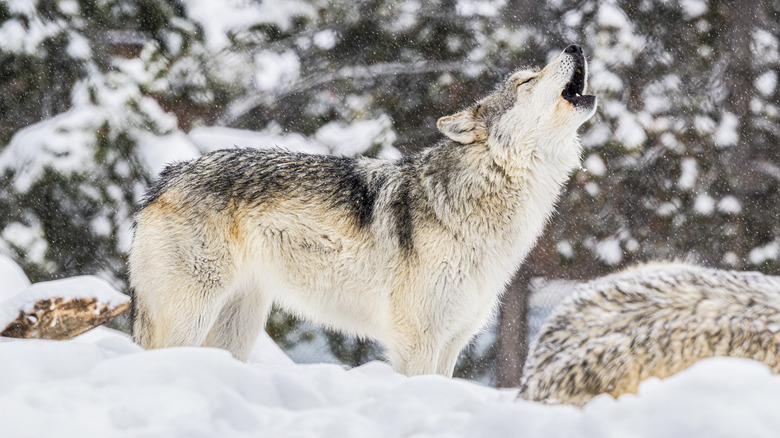Why Wolf-Watching Is Quickly Becoming A Favorite Recreational Vacation Activity
The relationship between humans and wolves has long been a complicated. Wolves have appeared in many long-told legends, often as the villain in stories like "Little Red Riding Hood," and they've often been vilified as killers of livestock and game that people rely on. But beyond any myths and preconceptions, it's undeniable that wolves are a keystone species in much of North America. Removing them from an ecosystem throws it out of balance, and that is what happened across much of the United States. Recently, however, wolf populations have rebounded, bringing healthier ecosystems and new opportunities for people to once again see wolves in the wild. Watching these charismatic, intelligent pack animals has become a significant draw.
There was once an estimated 2 million wolves in North America, but these apex predators were hunted and poisoned throughout much of the late 1800s and early 1900s, nearly disappearing from the continental U.S. But thanks to intensive (and sometimes divisive) reintroduction and relocation work, you can now see gray wolf packs back in parts of their historic range, including national parks such as the ever-popular Yellowstone in Wyoming, the remote but adventure-packed Isle Royal in Michigan, and the hidden gem that is Rocky Mountain in Colorado.
Restoring wolves to their natural habitats not only brings greater balance in the ecosystem, but it has also provided an unexpected tourism boost. Many people are looking for was to connect with the natural world, and few experiences feel as primal self as spending time searching for, learning about, and watching wolves.
Great places to see wolves
Wolf tourism offers more than the chance to see wolves — it also provides an economic boost to local communities. A 2022 tourism study sponsored by Wild Livelihoods found that wolf-related tourism generated $82 million in the Greater Yellowstone Ecosystem (GYE), which includes both Yellowstone and Grand Teton national parks. The revenue creates an added incentive to protect wolves and their habitat.
If you're seeking a wolf sighting in the continental U.S., few better places are better than the GYE. Winter is generally the best time to spot wolves, though in spring, you may be able to see wolf pups. If you're on a tight budget for to swing a Yellowstone adventure, consider focusing on Lamar Valley and the nearby Slough Creek, both known wolf habitas. For a naturalist guided experience, Jackson Hole Wildlife EcoTour Adventures, a highly regarded tour operator, leads small-group wildlife trips, including multi-day tours. Because wildlife, especially wolves, can be elusive, so the more time and patience you dedicate to searching, the greater your chances of success.
For guaranteed sightings, several wildlife centers house wolves that cannot safely live in the wild and now essentially act as ambassadors for their species. The Colorado Wolf and Wildlife Center, about a 10-minute drive from Woodland Park, Colorado, a small town where nature takes center stage, offers tours designed to educate visitors and support conservation efforts, including opportunies to interact with the animals. And at Wolf Creek Habitat and Rescue in Brookville, Indiana, guests can even spend the night on the property and listen for the wolves' iconic and haunting howls.

